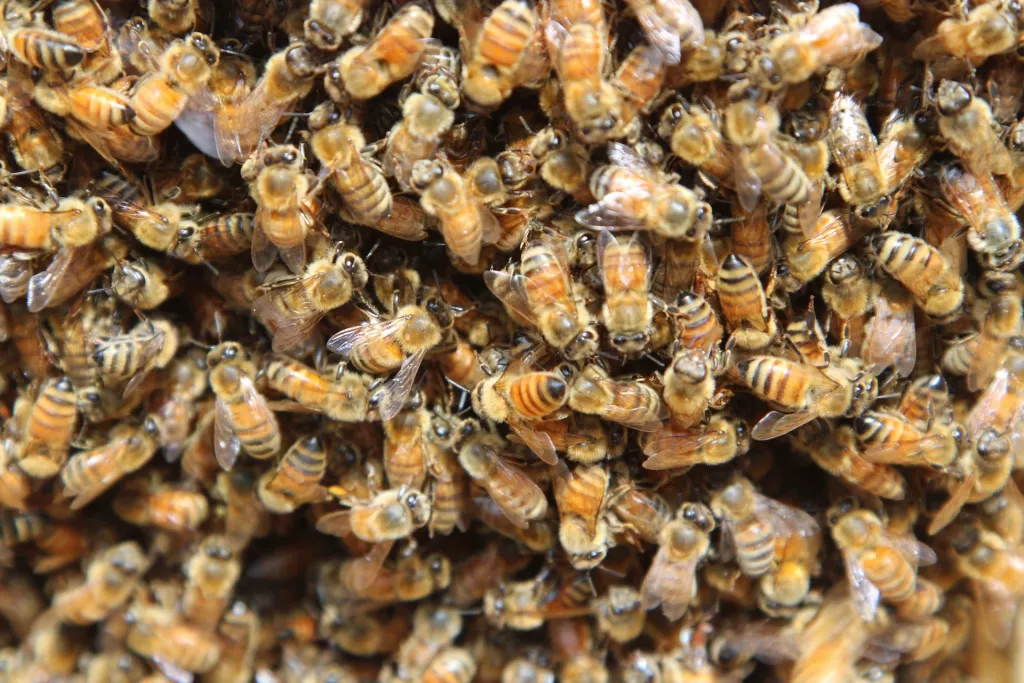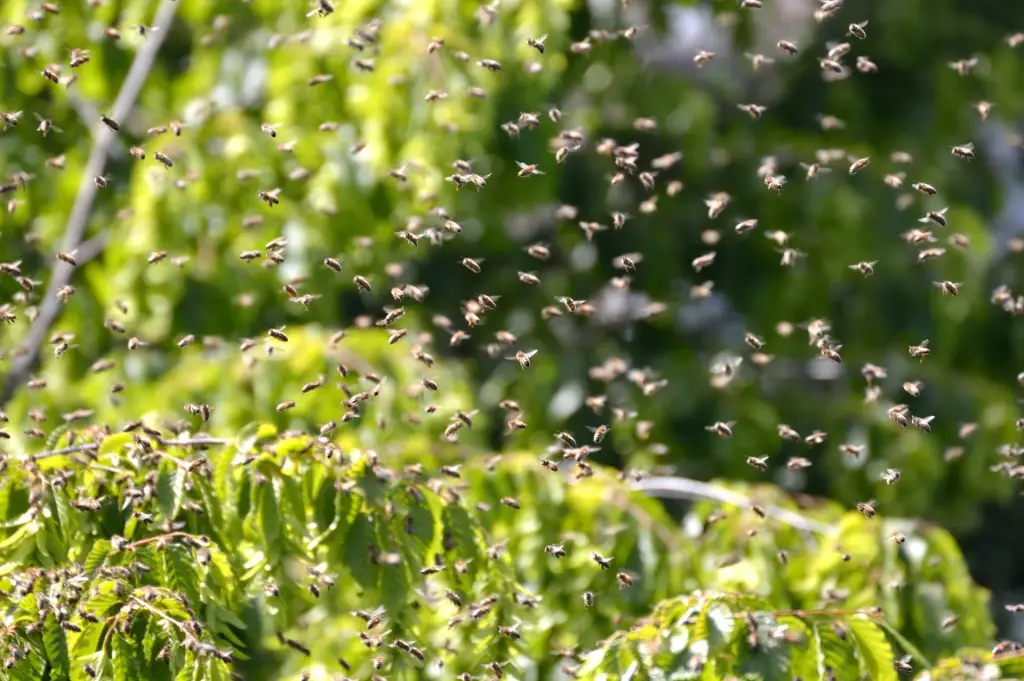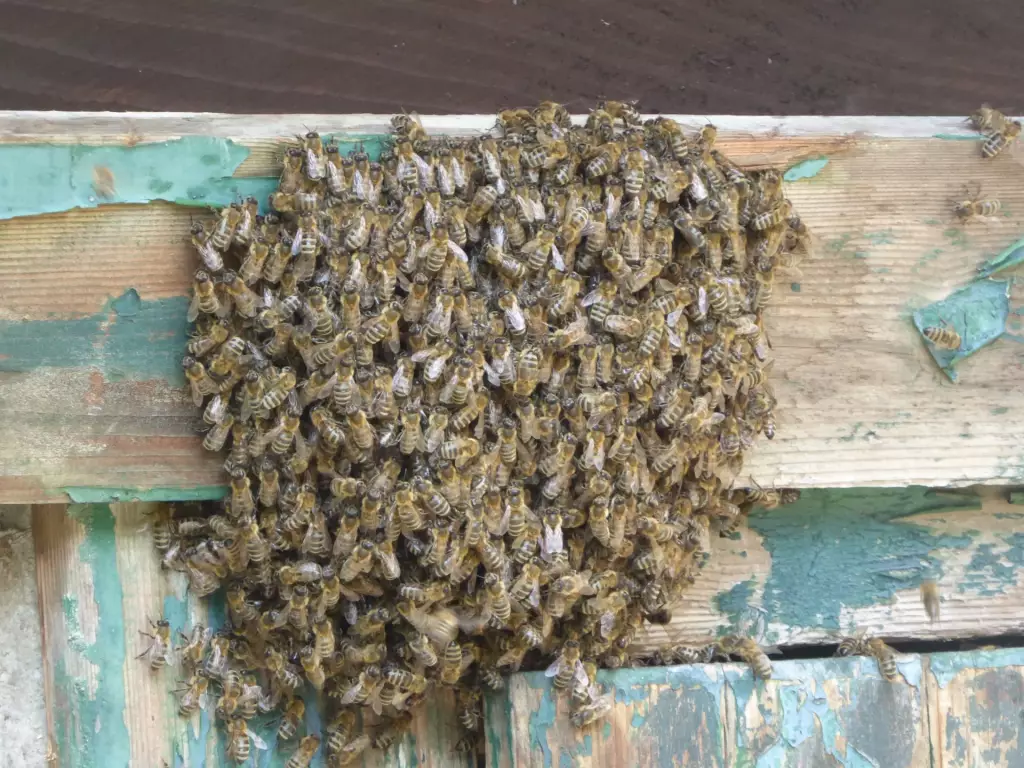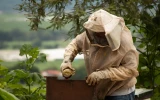Bearding vs. Swarming: 5 Key Differences Explained
Are your bees about to ghost you or do they just need a little air? Bearding and swarming are common colony behaviors and it's important to know how to identify them. Find out how to differentiate between the two with this guide.
Bearding is a quiet, defensive attempt to cool down the hive in the summer, usually in the early evening when all the bees are home. Swarming is a loud, airborne relocation of a part of the colony around noontime in the spring.
Both bearding and swarming will need your attention. You may need to purchase a new hive, conduct supplementary feeding, or move the hive depending on what your bees are up to and how serious the issue is. I'll explain how you can tell the difference so that you can act ahead.
Summary
- If the bees are quiet, fanning their wings, and gathered outside the hive during the early evenings in the summer, then they're probably bearding.
- If the bees are loud, frantic, and airborne from 11am to 2pm in the springtime, they they're probably swarming.

On this page:
What Does Bearding and Swarming Mean?
Bees go bearding when it's too hot to stay inside the hive. Alternatively, swarming refers to when a part of the colony breaks off to find a new hive and live as a separate colony.
What are the Key Differences Between Bearding and Swarming?
| Bearding | Swarming | |
|---|---|---|
| Season | Summer, early evening | Spring, mid-morning to early afternoon |
| Noise Levels | Minimal | High-pitched squeaking and buzzing from inside the hive |
| Activity Levels | Gathered outside the hive | Constantly on the move, airborne |
| Personality | Aggressive, to protect honey stores | Happy and well-fed due to sufficient honey supply |
When it usually happens
Bearding usually occurs in the summer, when the weather is hot and humid. It's one of the ways they regulate the hive's internal temperature and humidity.
Alternatively, bearding could also happen when there is not enough space in the hive, or when you are treating your bees with certain mite treatments. If it's the latter, make sure to read the directions on the label; these products will usually mention the possibility of bearding activity ahead of time.
Swarming happens in the spring time, when nectar flow is heaviest and hives have plenty of honey. This can be a signal for bees to separate and create their own colony, bringing the excess honey along to help establish themselves while they assert independence.
What time of day it occurs
Bearding usually happens in the evening. This is when all the forager bees have come home for the night. There are so many bees in one location and plenty of body heat to go around, so it's usually when the temperature inside the hive is at its highest. Any bees staying inside the brood box will start pushing air throughout the hive, and part of this process involves fanning at the entrance. Any workers that are not on brood duty or attending to the queen will be working on keeping the colony cool.
Meanwhile, bees usually choose to swarm between 11am and 2pm. Swarming is a big job and it's not just about finding a new place to live. It's also about relocating the honey they need to start off on the right foot, and protecting the queen to keep the swarm together.
How noisy the bees get
Noise levels are a good indicator between bearding and swarming. Bees who are bearding are trying to beat the heat while conserving their energy. As a result, they won't be making a lot of noise.
Loud and frantic clusters of bees are probably swarming. Aside from being incredibly busy, they also need to project a strong front to protect the queen as she is transferred to the new colony.
How active the bees become
When bees are bearding, they are only gathered around the hive. They almost look like they're enjoying a quiet night out after a long day of work. Conversely, swarms move around rapidly and are airborne. There is no time to slow down when they are dedicated to the monumental job of relocating safely.

How to Handle Swarming
If you feel like your bees are about to swarm, you can try setting up a new hive close by so that they move into a location that is convenient for you.
You can even intervene while the swarm is already happening. Try catching the queen, placing her in a queen cage, and moving her to a new location.
But if you're too late and the hive has already swarmed, check on the original colony—particularly the hive colony. It should contain multiple queen cells. While a newly emerged queen will instinctively kill all the other queens in the hive after they hatch, you can also do it yourself to make their job easier.
Overall, it's important to check the health of the queen for both the original colony and the new swarm.
How to Detect Signs of a Swarming
They've built comb to the edges of the frame
If the frames are nearly filled with comb, then it is possible that the bees will swarm. At this point, they've outgrown the hive and need more space. Hives that are overpopulated will also have idle bees who are not assigned to any work around the hive.
To prevent swarming, considering adding another hive body to your frame or more supers.
There are queen cells in the hive
Queen cells are specially made by worker bees, whose reproductive organs only mature when they believe their queen is dying or they are about to kick her out. Once you see these cells, first check the health and wellbeing of the queen bee.

How to Resolve Bearding
Give your bees food and water
In the middle of a heat wave, your bees will need all the energy and hydration they can get to stay alive. Use your discretion to decide whether they need to have supplemental feeding in the form of pollen patties and sugar water, based on how hot it gets where you live and how your bees are acting.
Don't bug them too much
You do not want to approach bees or conduct inspections when they're bearding. They are tired, sweaty, and cranky. If you try to take a look at the hive when they're bearding, you are more likely to get stung.
In addition, hive inspections may interfere with their efforts to regulate hive temperature. Reschedule your visit to the next day or a later date instead.
Inspect the hive as soon as you can
Once it's safe to inspect the hive, prioritize seeing how the other members of the colony are doing. Check on the queen, the brood, and the combs. Excessive heat can cause the wax to melt, and kill off the queen and brood.
Consider moving the hive
If your bees are constantly bearding, then consider relocating the hive. Try looking for a place with plenty of morning sunlight and afternoon shade.
Are Bearding and Washboarding the Same?
Washboarding is an interesting bee phenomenon we don't quite have the explanation for yet. It is unrelated to bearding.
Unlike bearding, washboarding can happen any time of the day and the bees usually give each other a little space. They'll need this space to rock back and forth on their front legs, a lot like they're scrubbing clothes on a washboard.
Experts speculate that bees washboard to clean the hive spread pheromones, or remove tiny grains of pollen that cause discomfort. Regardless, this is nothing to worry about and it's fun to watch.
